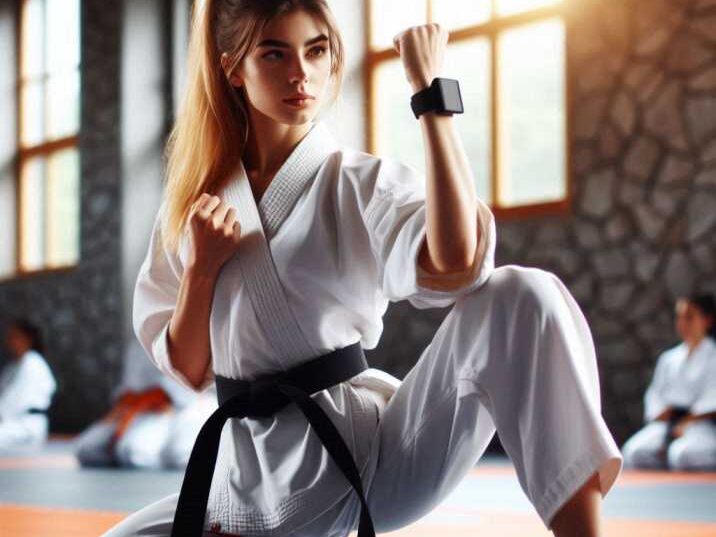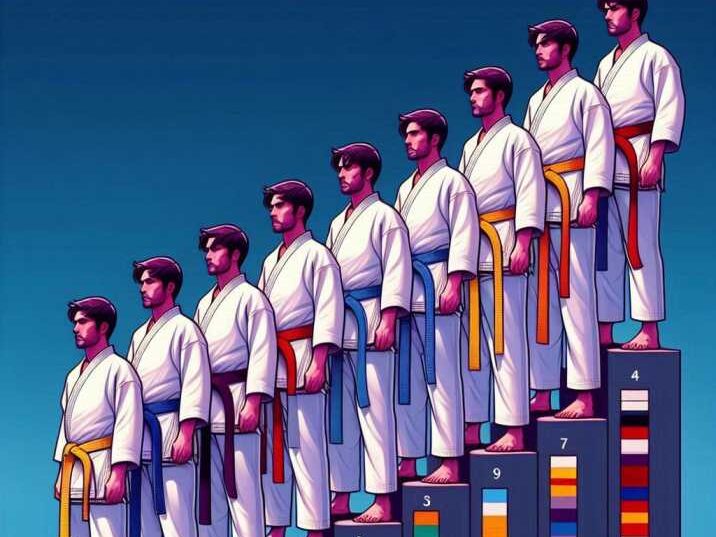Introduction
Table of Contents
Karate is a fascinating martial art that requires not just physical skill but also mental focus and dedication. As students practice karate, they progress through different belt levels, each representing their skill and knowledge. The highest belt in karate signifies the pinnacle of achievement in this discipline. In this article, we will explore what the highest belt in karate is, how karate practitioners earn their belts, and why this journey is important for personal growth. Let’s dive into the world of karate and discover what it takes to reach the top!

What is Karate?
Karate is a martial art that originated in Japan. It focuses on striking techniques such as punching, kicking, and knee strikes. Practitioners also learn self-defense and develop their physical and mental strength. Karate is not just about fighting; it’s also about discipline, respect, and improving oneself.
Key Components of Karate
Karate is a martial art with a rich tradition that focuses on physical techniques, mental discipline, and the development of personal character. Understanding the key components of karate helps practitioners appreciate the depth and complexity of this martial art. Here’s a detailed look at the essential elements of karate:
Kata
Kata refers to a set of pre-arranged movements and techniques performed in a specific sequence. Each kata is a choreographed pattern of moves that represents a series of combat scenarios.
Purpose:
Practice Techniques: Kata allows practitioners to practice and perfect their techniques in a structured manner.
Develop Muscle Memory: By repeatedly performing kata, students build muscle memory, which helps in executing techniques more effectively during sparring.
Understand Principles: Kata helps in understanding the fundamental principles of karate, including balance, timing, and precision.
Example: A well-known kata is “Heian Shodan,” which is often practiced by beginners to develop basic skills and techniques.
Kumite
Kumite is the term for sparring or fighting with an opponent. It involves the application of karate techniques in a live, interactive setting.
Purpose:
- Apply Techniques: Kumite allows practitioners to apply the techniques learned in kata and basics against a real opponent.
- Improve Reflexes: Sparring helps in improving reflexes and reaction time, which are crucial in real combat situations.
- Enhance Strategy: Practicing kumite develops strategic thinking and adaptability as students learn to respond to an opponent’s actions.
Example: In a typical kumite match, two karate practitioners face off and use a combination of offensive and defensive techniques within a set of rules to score points.
Basics
Basics refer to fundamental techniques in karate, including punches, kicks, blocks, and stances. These techniques form the foundation of all karate practice.
Purpose:
- Build Foundation: Mastering the basics is essential for developing strong and effective techniques. They are the building blocks for more advanced skills.
- Enhance Power and Accuracy: Practicing basics helps in developing power, speed, and accuracy in techniques.
- Establish Discipline: Regular practice of basic techniques fosters discipline and focus, which are crucial for progress in karate.
Karate Belts and Their Significance
In karate, the different colored belts symbolize a student’s progress and skill level. Each belt represents a stage of development and achievement in the martial art, reflecting both technical ability and personal growth.

White Belt
The white belt is the starting point for all karate students, symbolizing purity and a blank slate. At this level, students begin learning the basics of karate, including fundamental techniques and principles.
Yellow Belt
The yellow belt signifies the initial progress in karate. Students start to understand and apply basic techniques, building a foundation for more advanced skills. It represents the growth and development that occurs after mastering the fundamentals.
Orange Belt
The orange belt represents the intermediate level, where students refine their techniques and begin learning more advanced moves. This stage marks significant progress as students develop greater control and skill in their practice.
Green Belt
The green belt indicates an increased level of proficiency and deeper understanding of karate techniques. Students at this level start to integrate their skills into more complex patterns and applications.
Blue Belt
The blue belt signifies a higher level of expertise with more complex techniques and forms. Students continue to refine their skills and develop a deeper grasp of karate’s principles and strategies.
Purple Belt
The purple belt represents advanced skills and a more profound understanding of karate. Students at this stage are expected to demonstrate a high level of technique, precision, and application in their practice.
Brown Belt
The brown belt is a pre-black belt stage where students focus on high-level techniques and leadership. This belt signifies near-mastery and prepares students for the rigorous testing required to achieve a black belt.
Black Belt
The black belt is the highest rank in karate, symbolizing mastery and a deep commitment to the art. Achieving a black belt reflects years of dedicated practice, skill development, and personal growth, with ongoing learning and improvement continuing beyond this rank.
The Highest Belt in Karate
The black belt is the pinnacle of achievement in karate, representing years of hard work, dedication, and skill development. Reaching this level is a significant milestone, but it’s just the beginning of a lifelong journey in martial arts.
First Dan
The First Dan is the initial level of the black belt and marks the achievement of a high level of proficiency in karate. At this stage, students have mastered fundamental techniques and are now ready to delve into more advanced aspects of the art.
Higher Dans
Higher Dans, ranging from Second Dan to Tenth Dan, represent further advancement within the black belt rank. Each level requires more rigorous testing and deeper understanding of karate, reflecting a continuous journey of improvement and mastery.
Testing
Black belt testing is a rigorous process where practitioners demonstrate their advanced techniques, kata (forms), and sparring skills. This comprehensive evaluation ensures that candidates have not only mastered technical skills but also possess the mental and strategic qualities of a true martial artist.
Why is the Black Belt Important?
- Represents Mastery: The black belt signifies a high level of skill and extensive knowledge in karate, reflecting years of dedicated practice and expertise.
- Focus and Discipline: Achieving a black belt requires exceptional dedication and discipline, showcasing a practitioner’s commitment to the art and personal growth.
- Leadership: Black belts often assume leadership roles within karate schools, guiding and mentoring lower-ranking students and contributing to the karate community.
How to Achieve the Highest Belt in Karate?
Achieving the highest belt in karate, the black belt, requires dedication, skill, and continuous improvement. Here’s how to navigate this challenging journey:
Commitment
Explanation: Regular training and practice are crucial for progress in karate. Consistent effort and dedication help build the skills and discipline needed to advance through the ranks.
Skill Development
Explanation: Mastering karate techniques and kata (forms) is essential for achieving a black belt. Students must refine their abilities and demonstrate proficiency in both fundamental and advanced skills.
Testing
Explanation: Formal testing is a key part of earning a black belt. Practitioners must showcase their techniques, kata, and sparring skills in rigorous evaluations to prove their readiness for higher ranks.
Continuous Learning
Explanation: Karate is a lifelong journey of growth and learning. Even after achieving a black belt, practitioners must continue to study and improve their skills, staying open to new techniques and insights.
Steps to Achieve a Black Belt
- Start Early: Begin training as a white belt and work your way through each rank, progressively learning and mastering new skills.
- Set Goals: Establish specific, achievable goals for each belt level to stay focused and motivated throughout your training journey.
- Seek Guidance: Learn from experienced instructors and mentors who can provide valuable insights, feedback, and support as you advance.
- Stay Motivated: Maintain a strong commitment to practice and improvement, even when facing challenges or setbacks.
The Benefits of Karate Training
Karate training provides a range of benefits that extend beyond the dojo and into everyday life. Here’s how practicing karate can positively impact various aspects of your life:
Improved Focus
Explanation: Karate training requires intense concentration and mental discipline, which can enhance focus in other areas, such as school or work. The ability to concentrate on specific techniques and forms translates into better attention to detail and productivity in daily tasks.
Discipline
Explanation: The structured environment of karate teaches self-discipline and respect for others. Following the rules of the dojo, adhering to training schedules, and practicing techniques diligently help students develop a strong sense of discipline that can be applied in various aspects of life.
Physical Fitness
Explanation: Regular karate practice improves overall physical fitness by increasing strength, flexibility, and endurance. The dynamic movements involved in karate, including strikes, kicks, and stances, contribute to better cardiovascular health, muscle tone, and physical coordination.
Confidence
Explanation: Advancing through the ranks and achieving higher belts in karate builds self-confidence and self-esteem. Each accomplishment, from mastering a new technique to passing a belt test, reinforces a sense of personal achievement and boosts self-assurance.
Table of Information
| Belt Color | Significance | Key Skills |
|---|---|---|
| White | Beginner | Basic techniques |
| Yellow | Initial progress | Fundamental skills |
| Orange | Intermediate | Advanced techniques |
| Green | Growing proficiency | Enhanced skills |
| Blue | Higher level | Complex techniques |
| Purple | Advanced understanding | Deeper knowledge |
| Brown | Pre-black belt | High-level techniques |
| Black | Mastery | Expertise and leadership |
Conclusion
Achieving the highest belt in karate, the black belt, is a significant accomplishment that reflects years of hard work, dedication, and skill. It symbolizes not just mastery of karate techniques but also personal growth and development. Whether you are just starting your karate journey or are working towards the black belt, remember that the path is as important as the destination. Embrace the discipline and focus that karate teaches, and you’ll find success in both martial arts and in other areas of your life.
FAQs
1. What does a black belt in karate mean?
A black belt signifies advanced skill and knowledge in karate. It represents years of practice and dedication.
2. How long does it take to earn a black belt?
It varies by individual and dojo, but it typically takes several years of consistent training.
3. Are there different levels within the black belt?
Yes, the black belt has different degrees or “dans,” ranging from First Dan to Tenth Dan.
4. Can you stop training after earning a black belt?
No, earning a black belt is just the beginning. Continuous learning and practice are essential.
5. What is the most challenging part of earning a black belt?
The most challenging part is maintaining the discipline, focus, and dedication required for advanced training and testing.


